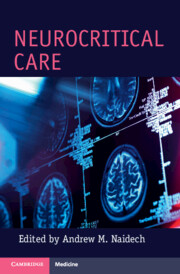Book contents
- Neurocritical Care
- Neurocritical Care
- Copyright page
- Contents
- Contributors
- 1 Introduction
- 2 Intracranial Pressure Monitoring and Management
- 3 Disorders of Temperature Regulation
- 4 Approach to Neuroimaging of the Brain, Vessels, and Cerebral Edema
- 5 Airway and Ventilator Management of the Neurologically Critically Ill Patient
- 6 Neurocritical Care Pharmacology
- 7 Intracerebral Hemorrhage
- 8 Correction of Coagulopathy
- 9 Subarachnoid Hemorrhage
- 10 Subdural Hematoma
- 11 Critical Care Management of Neurotrauma
- 12 Critical Care Management before and after Open and Intravascular Procedures
- 13 Shared Decision-Making in the Neuro-ICU
- 14 Status Epilepticus and EEG Monitoring
- 15 Evaluation of the Comatose Patient and Overview of the Brain Death Examination
- Index
- References
2 - Intracranial Pressure Monitoring and Management
Published online by Cambridge University Press: 19 May 2022
- Neurocritical Care
- Neurocritical Care
- Copyright page
- Contents
- Contributors
- 1 Introduction
- 2 Intracranial Pressure Monitoring and Management
- 3 Disorders of Temperature Regulation
- 4 Approach to Neuroimaging of the Brain, Vessels, and Cerebral Edema
- 5 Airway and Ventilator Management of the Neurologically Critically Ill Patient
- 6 Neurocritical Care Pharmacology
- 7 Intracerebral Hemorrhage
- 8 Correction of Coagulopathy
- 9 Subarachnoid Hemorrhage
- 10 Subdural Hematoma
- 11 Critical Care Management of Neurotrauma
- 12 Critical Care Management before and after Open and Intravascular Procedures
- 13 Shared Decision-Making in the Neuro-ICU
- 14 Status Epilepticus and EEG Monitoring
- 15 Evaluation of the Comatose Patient and Overview of the Brain Death Examination
- Index
- References
Summary
Intracranial hypertension is a life-threatening condition that if left unchecked can lead to brain herniation, cerebral ischemia, and brain death. Intracranial pressure (ICP) monitoring is frequently helpful for patient management. If placed, the monitor should be inserted in comatose patients at high risk for elevated ICP. ICP values, trends, and waveforms should be analyzed in conjunction with cerebral perfusion pressure (CPP) to guide therapy. Patients with elevated ICP can be managed using a tiered strategy that emphasizes cerebral spinal fluid drainage, sedation, and CPP optimization (tier one) prior to initiating bolus osmotherapy, hyperventilation, or paralysis (tier two). Multimodality monitoring therapy is a promising strategy that can detect secondary brain injury early and allow individualized treatment. Tier-three strategies for superrefractory ICP elevation include decompressive craniectomy, hypothermia, and pentobarbital infusion. Of these, craniectomy appears to be the most effective measure for reducing mortality, especially in younger patients.
- Type
- Chapter
- Information
- Neurocritical Care , pp. 6 - 31Publisher: Cambridge University PressPrint publication year: 2022
References
- 1
- Cited by

